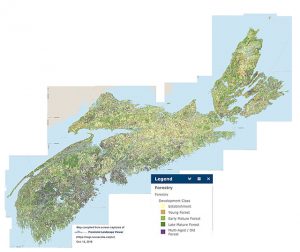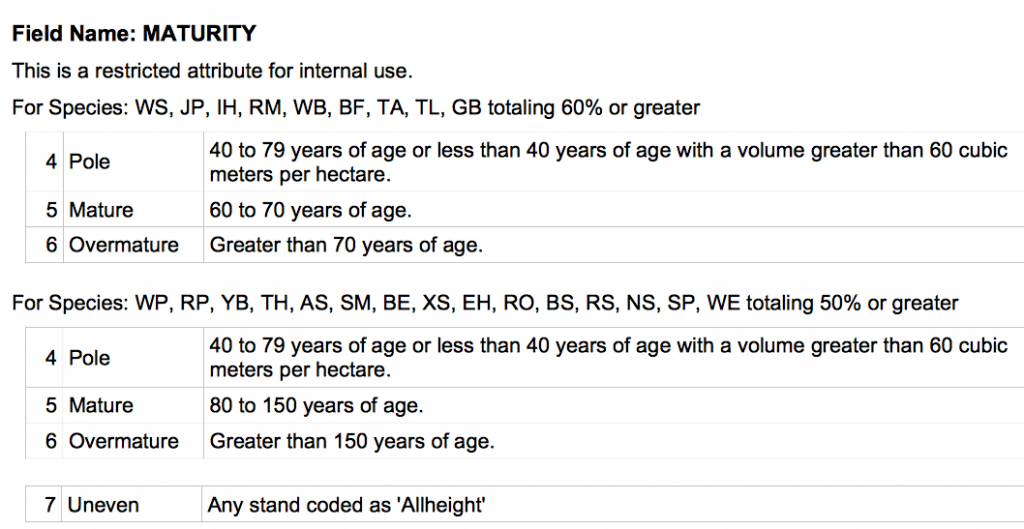Some time after 2019, the Early Mature and Late Mature categories were collapsed into one category (Mature); it’s not clear whether mature forest so labelled can be considered ‘Old Forest’ (forest 80 years and older). Given the clear evidence we have now that Old Forests (80 years & older) are critical for conservation of biodiversity, it would be welcomed if NRR maps personnel were to clearly define a category of Old Forest (forest known, or inferred based on multiple indices, to be 80 years of age and older), and include that as a new layer on both the Harvest Plan Map Viewer and the Provincial Landscape Viewer.

Distribution of forest in 5 development stages across Nova Scotia, compiled from NS Landscape Map Viewer in 2018. Purple = Multi-aged/Old Forest. Dark Green=Late Mature Forest. Click on image for larger version. View larger versions of the map: 2000 px | 4000 px.
Some time after 2019, the Early Mature and Late Mature categories were collapsed into one category (Mature).
This will be of interest to people who have been making use of the Forest Development Class layer on the the NS Provincial Landscape Viewer to get a sense of how much clearcutting there has been on landscape around new Crown harvest polygons shown on the Harvest Plan Map Viewer and/or how much Old Forest is left on a landscape (See HPMV – Forest Development Class).
I had been concentrating on the dark purple areas (Multi-aged/Old Forest) as the best indicators of Old Forest, but began to consider the dark green areas (late Mature Forest) as also indicative of Old Forest after a colleague suggested those are, generally, old Forest. I knew one example where that was certainly correct: “The Peninsula” on Sandy Lake, Bedford, which is dark green in the Forest Development Class Layer and the hemlock forest averaged 184 years (in 2014). That forest has a singe dominant older size class, and weak second size class, so I figured, Ok it wouldn’t be seen as multi-aged in aerial photographs, but otherwise has characteristics of Old Forest. So OK, the dark green is also ‘Old Forest’
Just recently, while consulting various older screen captures of Forest Development Class maps and more recent ones, I realized that the Early Mature Forest and Late Mature Forest categories have now been collapsed into one category: Mature Forests. Compare these two maps on the Sandy Lake (Bedford) area to see the difference (I chose this area as an example as I am quite familiar with it on the ground):

Forestry development Class for the Sandy Lake are accessed in 2017 (top) and 2022 (bottom) The arrow in the top figure points to “The Peninsula” where the hemlock stand averages approximately 200 years of age.
Click on image for larger version
The purple areas (2017) have all remained purple (2022); most dark green areas (2017) are now light green; a few below Hammonds Plains Road where there has been some harvesting have gone from dark green to brown so those seem to make sense. There are other areas that have gone from light green to brown that were not harvested as far as I know (so evidently the criteria for the “mature” category are somewhat different than before) but most of the light green areas in 2017 are light green in 2022.
Here is the description of the Development classes from the Help Menu accessed Jun 6, 2022.
Unfortunately I didn’t have a screen capture of how the Early Mature and Late Mature classes were described earlier. Here is how “Maturity” is defined in a 2021 Nova Scotia Interpreted Forest Inventory document
 So this suggests that the green areas we see on the maps now are at least 60 years old, 80+ years if the stands are mainly the Shade Tolerant species and Intermediate Shade Tolerant species.
So this suggests that the green areas we see on the maps now are at least 60 years old, 80+ years if the stands are mainly the Shade Tolerant species and Intermediate Shade Tolerant species.
To complicate matters somewhat, in a 2020 report on Forest Connectivity in Nova Scotia by Dalhousie and L&F researchers, Mature Forest is defined as “those forests with a minimum age of 40 years (provided as a maximum stand height of 12m”.
My conclusion: as a guide to where Old Forest remains in Nova Scotia, look at the distribution of purple patches on the Forest Development Class Layer of the Nova Scotia Provincial Landscape Viewer.
Comment: Given the clear evidence we have now that Old Forests (80 years & older) are critical for conservation of biodiversity, it would be welcomed if NRR maps were to clearly define a category of Old Forest (forest known, or inferred based on multiple indices, to be 80 years of age and older), and include that as a new layer on both the Harvest Plan Map Viewer and the Provincial Landscape Viewer – and provide the related stats such as the amount of Old Forest for the province as a whole, and for Crown lands and Private lands considered separately.
I would welcome any clarifications/comments from NRR!

